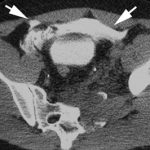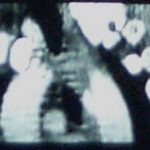Cervical spine clearance in obtunded trauma patients has always been controversial. Most physicians believe that evaluation of bones and ligaments is required, although there is a minority that say that the spine can be cleared purely by radiographs. This would greatly simplify the process and decrease costs.
A prospective study was presented at EAST in January that evaluated the use of CT alone to clear the c-spine in these patients. It was presented by Claridge et al from MetroHealth in Cleveland, and is an expansion of an earlier prospective they performed. Based on the original study, the protocol was revised and the results of this re-study was presented.
The study involved 197 patients who were victims of blunt trauma, obtunded, and were noted to move all extremities. Short term mortality was 13% and long term mortality was 27%, which shows how badly injured this group was. The average ISS was 23 and the initial GCS was 8.
The following radiographic criteria were used to diagnose a significant c-spine injury:
- Fracture line extending on 2 consecutive CT slices
- Marked prevertebral soft tissue swelling or hematoma
- Malalignment not explained by degenerative changes
- Abnormal facets or posterior malalignment on sagittal reconstruction
- Occipital condyle injury involving the craniocervical junction
Followup was performed either by re-examination after awakening (62%), followup by phone or chart review (12%), or MRI for persistent c-spine pain (2%). Thirteen percent died before re-evaluation, and 11% were lost to followup.
Using this protocol, the average hospital day of clearance decreased from 7.5 to 3.3, the incidence of decubitus ulcer from the collar decreased from 5% to 0.5%, and the average length of stay decreased from 23 to 14 days. All of these results were statistically significant.
The authors recognized that long term followup was lacking in this study and there was the potential for missed injury. Power calculations show that there are not enough patients enrolled to give a statistically sound result. The issue of spinal cord injury without radiographic abnormality (SCIWORA) is always a possibility.
The bottom line: clearance based on radiographs alone is still not ready for prime time. Some injuries will ultimately be missed, and a fraction of those can cause devastating injury. The real question to be answered is “How many missed injuries is okay?” Until more and better work is done, some combination of radiographic and clinical techniques must be used.
Reference: A normal CT alone may clear the cervical spine in obtunded blunt trauma patients with gross extremity movement – a prospective evaluation of a revised protocol. Claridge et al, MetroHealth Medical Center. Presented at the 23rd Annual Scientific Assembly of the Eastern Association for the Surgery of Trauma, January 2010.


